中考英语考试必考重点词语辨析大全
- 格式:pdf
- 大小:50.21 KB
- 文档页数:8
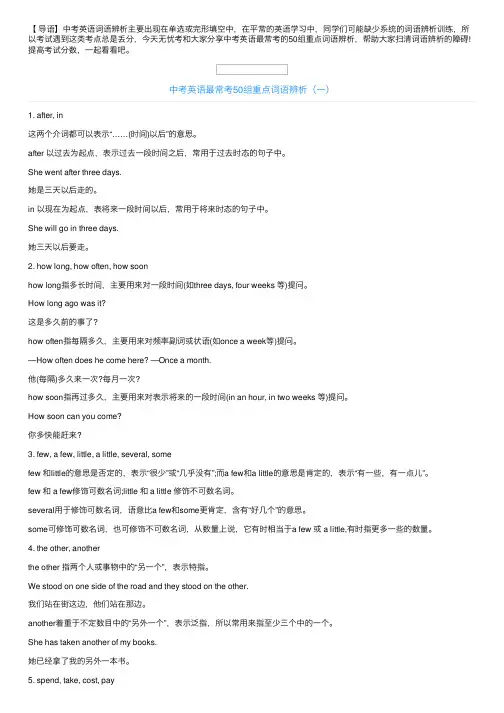
【导语】中考英语词语辨析主要出现在单选或完形填空中,在平常的英语学习中,同学们可能缺少系统的词语辨析训练,所以考试遇到这类考点总是丢分,今天⽆忧考和⼤家分享中考英语最常考的50组重点词语辨析,帮助⼤家扫清词语辨析的障碍!提⾼考试分数,⼀起看看吧。
中考英语最常考50组重点词语辨析(⼀)1. after, in这两个介词都可以表⽰“……(时间)以后”的意思。
after 以过去为起点,表⽰过去⼀段时间之后,常⽤于过去时态的句⼦中。
She went after three days.她是三天以后⾛的。
in 以现在为起点,表将来⼀段时间以后,常⽤于将来时态的句⼦中。
She will go in three days.她三天以后要⾛。
2. how long, how often, how soonhow long指多长时间,主要⽤来对⼀段时间(如three days, four weeks 等)提问。
How long ago was it?这是多久前的事了?how often指每隔多久,主要⽤来对频率副词或状语(如once a week等)提问。
—How often does he come here? —Once a month.他(每隔)多久来⼀次?每⽉⼀次?how soon指再过多久,主要⽤来对表⽰将来的⼀段时间(in an hour, in two weeks 等)提问。
How soon can you come?你多快能赶来?3. few, a few, little, a little, several, somefew 和little的意思是否定的,表⽰“很少”或“⼏乎没有”;⽽a few和a little的意思是肯定的,表⽰“有⼀些,有⼀点⼉”。
few 和 a few修饰可数名词;little 和 a little 修饰不可数名词。
several⽤于修饰可数名词,语意⽐a few和some更肯定,含有“好⼏个”的意思。
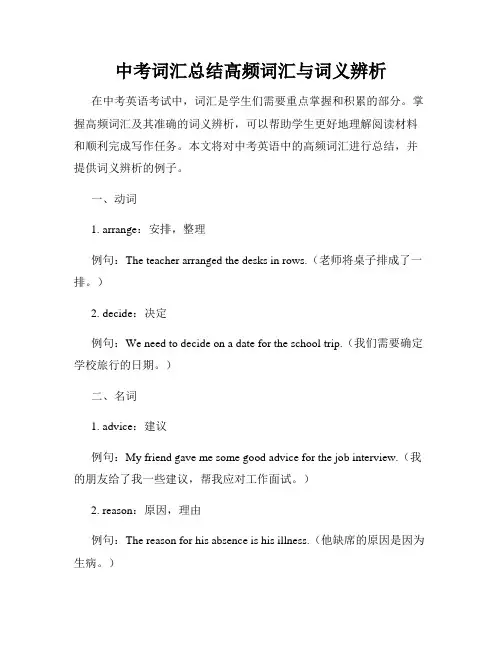
中考词汇总结高频词汇与词义辨析在中考英语考试中,词汇是学生们需要重点掌握和积累的部分。
掌握高频词汇及其准确的词义辨析,可以帮助学生更好地理解阅读材料和顺利完成写作任务。
本文将对中考英语中的高频词汇进行总结,并提供词义辨析的例子。
一、动词1. arrange:安排,整理例句:The teacher arranged the desks in rows.(老师将桌子排成了一排。
)2. decide:决定例句:We need to decide on a date for the school trip.(我们需要确定学校旅行的日期。
)二、名词1. advice:建议例句:My friend gave me some good advice for the job interview.(我的朋友给了我一些建议,帮我应对工作面试。
)2. reason:原因,理由例句:The reason for his absence is his illness.(他缺席的原因是因为生病。
)三、形容词1. polite:有礼貌的例句:Emily is always polite to her elders.(艾米莉对长辈总是非常有礼貌。
)2. honest:诚实的例句:He is an honest person and never tells lies.(他是一个诚实的人,从不说谎。
)四、副词1. quickly:快速地例句:She finished the race quickly and won the first place.(她迅速完成了比赛并获得了第一名。
)2. quietly:安静地例句:Please read quietly in the library.(请在图书馆安静地阅读。
)词义辨析:1. forget与remember虽然forget和remember都有“记住”的意思,但用法上有所不同。
forget表示“忘记”,后接名词或动名词,而remember表示“记得”,后接名词、动名词、动词-ing形式或从句。
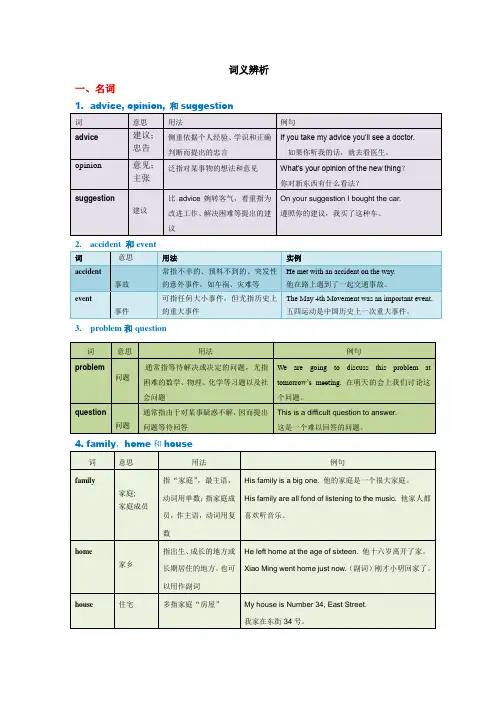

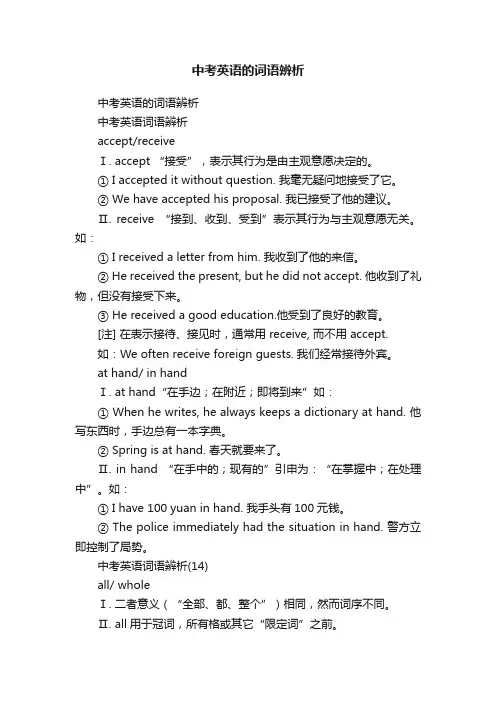
中考英语的词语辨析中考英语的词语辨析中考英语词语辨析accept/receiveⅠ. accept “接受”,表示其行为是由主观意愿决定的。
① I accepted it without question. 我毫无疑问地接受了它。
② We have accepted his proposal. 我已接受了他的建议。
Ⅱ. receive “接到、收到、受到”表示其行为与主观意愿无关。
如:① I received a letter from him. 我收到了他的来信。
② He received the present, but he did not accept. 他收到了礼物,但没有接受下来。
③ He received a good education.他受到了良好的教育。
[注] 在表示接待、接见时,通常用 receive, 而不用 accept.如:We often receive foreign guests. 我们经常接待外宾。
at hand/ in handⅠ. at hand“在手边;在附近;即将到来”如:① When he writes, he always keeps a dictionary at hand. 他写东西时,手边总有一本字典。
② Spring is at hand. 春天就要来了。
Ⅱ. in hand “在手中的;现有的”引申为:“在掌握中;在处理中”。
如:① I have 100 yuan in hand. 我手头有100元钱。
② The police immediately had the situation in hand. 警方立即控制了局势。
中考英语词语辨析(14)all/ wholeⅠ. 二者意义(“全部、都、整个”)相同,然而词序不同。
Ⅱ. all用于冠词,所有格或其它“限定词”之前。
whole 则用于冠词之后。
如:① all the time. ────→the whole time.全部时间② all my life ────→the whole life.我的一生③ all this confusion ─→ this whole confusion.整个混乱状况。
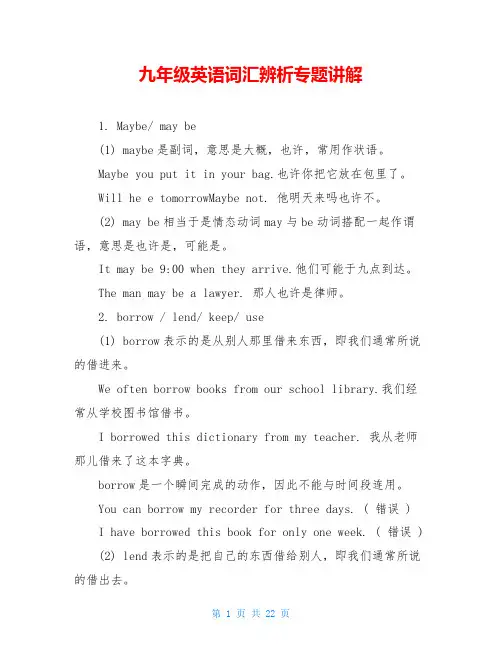
九年级英语词汇辨析专题讲解1. Maybe/ may be(1) maybe是副词,意思是大概,也许,常用作状语。
Maybe you put it in your bag.也许你把它放在包里了。
Will he e tomorrowMaybe not. 他明天来吗也许不。
(2) may be相当于是情态动词may与be动词搭配一起作谓语,意思是也许是,可能是。
It may be 9:00 when they arrive.他们可能于九点到达。
The man may be a lawyer. 那人也许是律师。
2. borrow / lend/ keep/ use(1) borrow表示的是从别人那里借来东西,即我们通常所说的借进来。
We often borrow books from our school library.我们经常从学校图书馆借书。
I borrowed this dictionary from my teacher. 我从老师那儿借来了这本字典。
borrow是一个瞬间完成的动作,因此不能与时间段连用。
You can borrow my recorder for three days. ( 错误 )I have borrowed this book for only one week. ( 错误 )(2) lend表示的是把自己的东西借给别人,即我们通常所说的借出去。
Thank you for lending me your bike.谢谢你把自行车借给我。
He often lends money to his brother.他经常借钱给他弟弟。
lend与borrow一样,也是一个瞬间完成的动作,不能与一段时间连用。
(3) keep的意思也是借,但一般是指借来后的保存或使用阶段,是一段持续的时间,因此可以与时间段连用。
You can keep my recorder for three days.我的录音机你可以借用三天。
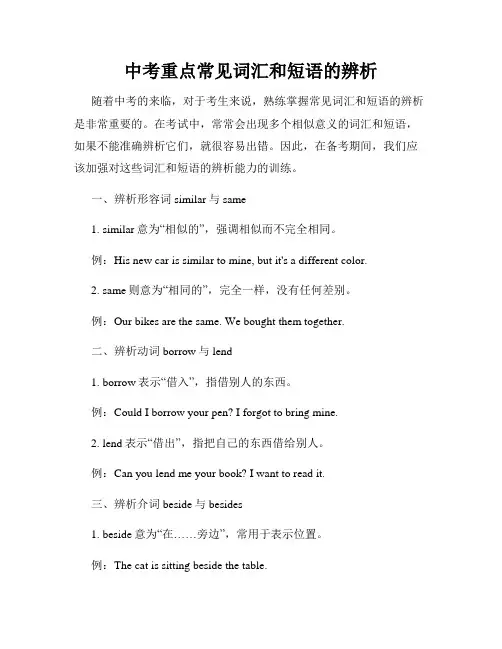
中考重点常见词汇和短语的辨析随着中考的来临,对于考生来说,熟练掌握常见词汇和短语的辨析是非常重要的。
在考试中,常常会出现多个相似意义的词汇和短语,如果不能准确辨析它们,就很容易出错。
因此,在备考期间,我们应该加强对这些词汇和短语的辨析能力的训练。
一、辨析形容词similar与same1. similar意为“相似的”,强调相似而不完全相同。
例:His new car is similar to mine, but it's a different color.2. same则意为“相同的”,完全一样,没有任何差别。
例:Our bikes are the same. We bought them together.二、辨析动词borrow与lend1. borrow表示“借入”,指借别人的东西。
例:Could I borrow your pen? I forgot to bring mine.2. lend表示“借出”,指把自己的东西借给别人。
例:Can you lend me your book? I want to read it.三、辨析介词beside与besides1. beside意为“在……旁边”,常用于表示位置。
例:The cat is sitting beside the table.2. besides意为“除了……之外”,常用于表示除了某事物或某人之外还有其他的事物或人。
例:Besides apples, we also have oranges.四、辨析动词learn与teach1. learn表示“学习”,指通过努力和训练获取新的知识或技能。
例:I learn English every day.2. teach表示“教”,指教授知识或技能给他人。
例:She teaches us math every Monday.五、辨析连词unless与if1. unless意为“除非”,相当于if not。
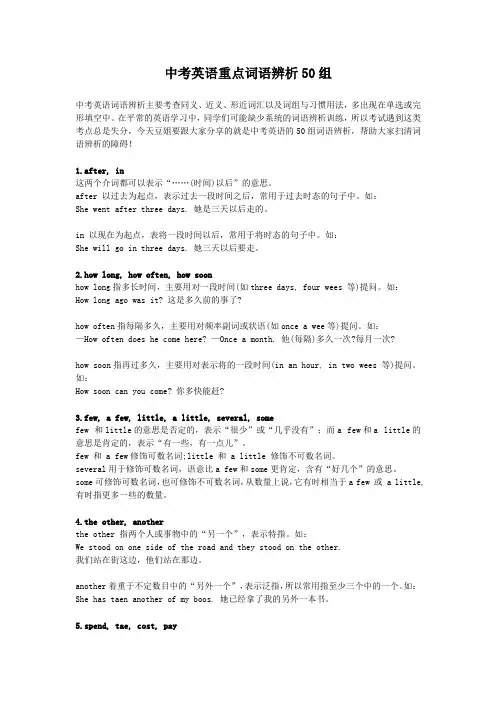
中考英语重点词语辨析50组中考英语词语辨析主要考查同义、近义、形近词汇以及词组与习惯用法,多出现在单选或完形填空中。
在平常的英语学习中,同学们可能缺少系统的词语辨析训练,所以考试遇到这类考点总是失分,今天豆姐要跟大家分享的就是中考英语的50组词语辨析,帮助大家扫清词语辨析的障碍!1.after, in这两个介词都可以表示“……(时间)以后”的意思。
after 以过去为起点,表示过去一段时间之后,常用于过去时态的句子中。
如:She went after three days. 她是三天以后走的。
in 以现在为起点,表将一段时间以后,常用于将时态的句子中。
如:She will go in three days. 她三天以后要走。
2.how long, how often, how soonhow long指多长时间,主要用对一段时间(如three days, four wees 等)提问。
如:How long ago was it? 这是多久前的事了?how often指每隔多久,主要用对频率副词或状语(如once a wee等)提问。
如:—How often does he come here? —Once a month. 他(每隔)多久一次?每月一次?how soon指再过多久,主要用对表示将的一段时间(in an hour, in two wees 等)提问。
如:How soon can you come? 你多快能赶?3.few, a few, little, a little, several, somefew 和little的意思是否定的,表示“很少”或“几乎没有”;而a few和a little的意思是肯定的,表示“有一些,有一点儿”。
few 和 a few修饰可数名词;little 和 a little 修饰不可数名词。
several用于修饰可数名词,语意比a few和some更肯定,含有“好几个”的意思。
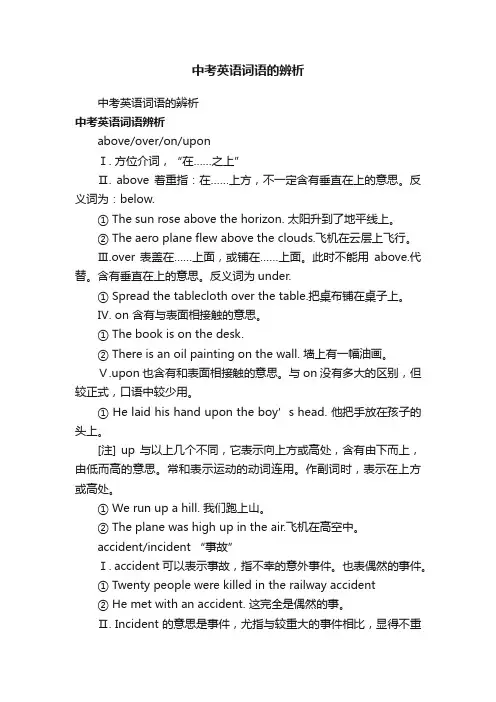
中考英语词语的辨析中考英语词语的辨析中考英语词语辨析above/over/on/uponⅠ. 方位介词,“在……之上”Ⅱ. above 着重指:在……上方,不一定含有垂直在上的意思。
反义词为:below.① The sun rose above the horizon. 太阳升到了地平线上。
② The aero plane flew above the clouds.飞机在云层上飞行。
Ⅲ.over 表盖在……上面,或铺在……上面。
此时不能用above.代替。
含有垂直在上的意思。
反义词为under.① Spread the tablecloth over the table.把桌布铺在桌子上。
Ⅳ. on 含有与表面相接触的意思。
① The book is on the desk.② There is an oil painting on the wall. 墙上有一幅油画。
Ⅴ.upon 也含有和表面相接触的意思。
与on没有多大的区别,但较正式,口语中较少用。
① He laid his hand upon the boy’s head. 他把手放在孩子的头上。
[注] up 与以上几个不同,它表示向上方或高处,含有由下而上,由低而高的意思。
常和表示运动的动词连用。
作副词时,表示在上方或高处。
① We run up a hill. 我们跑上山。
② The plane was high up in the air.飞机在高空中。
accident/incident “事故”Ⅰ. accident 可以表示事故,指不幸的意外事件。
也表偶然的事件。
① Twenty people were killed in the railway accident② He met with an accident. 这完全是偶然的事。
Ⅱ. Incident 的意思是事件,尤指与较重大的事件相比,显得不重要的事件。
它还可以表引起国际争端或战争的事件。
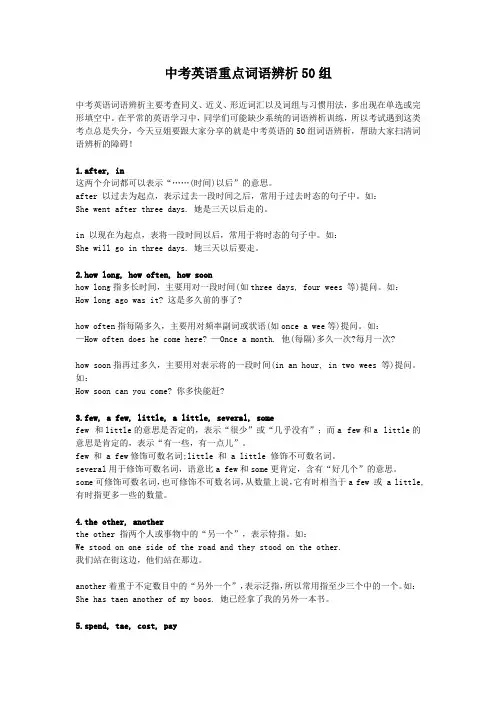
中考英语重点词语辨析50组中考英语词语辨析主要考查同义、近义、形近词汇以及词组与习惯用法,多出现在单选或完形填空中。
在平常的英语学习中,同学们可能缺少系统的词语辨析训练,所以考试遇到这类考点总是失分,今天豆姐要跟大家分享的就是中考英语的50组词语辨析,帮助大家扫清词语辨析的障碍!1.after, in这两个介词都可以表示“……(时间)以后”的意思。
after 以过去为起点,表示过去一段时间之后,常用于过去时态的句子中。
如:She went after three days. 她是三天以后走的。
in 以现在为起点,表将一段时间以后,常用于将时态的句子中。
如:She will go in three days. 她三天以后要走。
2.how long, how often, how soonhow long指多长时间,主要用对一段时间(如three days, four wees 等)提问。
如:How long ago was it? 这是多久前的事了?how often指每隔多久,主要用对频率副词或状语(如once a wee等)提问。
如:—How often does he come here? —Once a month. 他(每隔)多久一次?每月一次?how soon指再过多久,主要用对表示将的一段时间(in an hour, in two wees 等)提问。
如:How soon can you come? 你多快能赶?3.few, a few, little, a little, several, somefew 和little的意思是否定的,表示“很少”或“几乎没有”;而a few和a little的意思是肯定的,表示“有一些,有一点儿”。
few 和 a few修饰可数名词;little 和 a little 修饰不可数名词。
several用于修饰可数名词,语意比a few和some更肯定,含有“好几个”的意思。
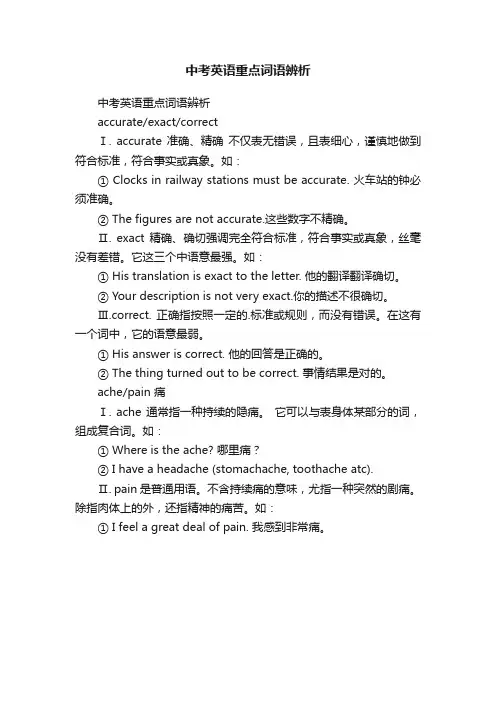
中考英语重点词语辨析中考英语重点词语辨析accurate/exact/correctⅠ. accurate 准确、精确不仅表无错误,且表细心,谨慎地做到符合标准,符合事实或真象。
如:① Clocks in railway stations must be accurate. 火车站的钟必须准确。
② The figures are not accurate.这些数字不精确。
Ⅱ. exact 精确、确切强调完全符合标准,符合事实或真象,丝毫没有差错。
它这三个中语意最强。
如:① His translation is exact to the letter. 他的翻译翻译确切。
② Your description is not very exact.你的描述不很确切。
Ⅲ.correct. 正确指按照一定的.标准或规则,而没有错误。
在这有一个词中,它的语意最弱。
① His answer is correct. 他的回答是正确的。
② The thing tu rned out to be correct. 事情结果是对的。
ache/pain 痛Ⅰ. ache 通常指一种持续的隐痛。
它可以与表身体某部分的词,组成复合词。
如:① Where is the ache? 哪里痛?② I have a headache (stomachache, toothache atc).Ⅱ. pain 是普通用语。
不含持续痛的意味,尤指一种突然的剧痛。
除指肉体上的外,还指精神的痛苦。
如:① I feel a great deal of pain. 我感到非常痛。
初中英语考试必考重点词语辨析汇总初中英语考试必考重点词语辨析汇总1. after, in这两个介词都可以表示(时间)以后的意思。
after 以过去为起点,表示过去一段时间之后,常用于过去时态的句子中。
如:She went after three days.她是三天以后走的。
in 以现在为起点,表将来一段时间以后,常用于将来时态的句子中。
如:She will go in three days.她三天以后要走。
2. how long, how often, how soonhow long指多长时间,主要用来对一段时间(如three days, four weeks 等)提问。
如:How long ago was it这是多久前的事了how often指每隔多久,主要用来对频率副词或状语(如once a week等)提问。
如:How often does he come here Once a month.他(每隔)多久来一次每月一次how soon指再过多久,主要用来对表示将来的一段时间(in an hour, in two weeks 等)提问。
如:How soon can you come你多快能赶来3. few, a few, little, a little, several, somefew 和little的意思是否定的,表示很少或几乎没有;而a few和a little的意思是肯定的,表示有一些,有一点儿。
few 和 a few修饰可数名词;little 和 a little 修饰不可数名词。
several用于修饰可数名词,语意比a few和some更肯定,含有好几个的意思。
some可修饰可数名词,也可修饰不可数名词,从数量上说,它有时相当于a few 或 a little,有时指更多一些的数量。
4. the other, anotherthe other 指两个人或事物中的另一个,表示特指。
中考英语词汇辨析1.spend,pay,cost,takesb. spend +时间/金钱 on sth. 某人在…上花费时间/金钱e.g. I spend two hours on English every day. 我每天花两小时学英语。
sb. spend +时间/金钱 (in) doing sth. 某人花费时间/金钱做某事e.g. Tom spends 5 dollar updating his computer system. Tom花五美元更新他的电脑系统。
sb. pay + 金钱 for…某人在...上花费金钱e.g. I paid 100 yuan for the shirt. 我花100元买这件T恤。
sth. cost sb. + 金钱/时间…花了某人的金钱/时间(cost的用法中,花金钱的出现频率比花时间高)e.g. It costs him ten euros. 它花了他十欧元。
It takes/took sb. +时间/金钱 to do sth. 花了某人时间/金钱做某事It takes me 6 minutes to take a shower. 冲澡花了我6分钟。
… take sb. +时间/金钱. …花了某人时间/金钱。
注意:spend和pay主语通常是人,而cost和take主语通常是物。
2.“at,on,in + 时间”at, on, in+时间,均可表示"在……的时候"。
at + 具体的时间点I get up at six o'clock in the morning . 我早晨六点起床。
Breakfast would be finished at seven.早餐将在七点结束。
on+具体某一天或具体某一个早上(下午、晚上)on Monday 在星期一on Sunday morning 在星期天早上(特指)on July 1st 在七月1日on a cold night in 1938 在1938年的一个寒冷的晚上in+具体某一年(季、月),早上,下午,晚上in 2020 在2020年in September 在九月in the morning 在早上(泛指)in the evening 在晚上可见at后跟的时间更精准,on次之,in排在最后。
初中中考英语常见词语辨析(一)(A--G)2.a few/ few(1)a few, few 用来修饰可数名词。
(2)a few “有一些”,表示肯定概念,few 几乎没有,表示否定意义。
[例] The man has been here for many years, so he has a few friends.这个人在这里住了很多年了,他有一些朋友。
I am a new comer here, so I have few friends here.我刚来到这里,所以我在这里没有几个朋友。
..........................................................................3.a little/ little(1) a little, little 用于修饰不可数名词。
(2) a little “有一些”,表示肯定概念。
little “几乎没有”,表示否定概念。
[例] There is a little water in the glass.杯子里有一些水。
There is little water in the glass, so you can’t drink any.杯子里几乎没有水了,你不可能喝到水了。
..........................................................................4.ago/ beforeago 只用于一般过去时,表示从现在算起的一段时间以前。
[例]He died two years ago.他是两年前去世的。
before 后接“时间点”,可用于任何时态;它也可放在“时间段”后,用于完成时或一般过去时。
[例]I got there before 5 o’clock.我五点钟前到达那里。
I never saw him before.我以前没见过他。
中考英语重点词汇辨析1.a bit/ a little(1)这两个词都意为“一点儿”有时可以互换,但有时不能。
Ⅰ.二者都可作程度副词修饰动词,形容词、副词或其比较级;意义相同,为“一点儿”“有些”。
如:①I am a bit / a little hungry.我有点饿。
②He walked a bit / a little slowly.他走路有点慢。
Ⅱ.二者都可以用作名词词组,充当主语或宾语。
如:① A little / bit is enough for me.我有一点儿就够了。
② I know only a little / a bit about her.我对她的情况只了解一点。
Ⅲ.区别:(1) a little可直接修饰名词;a bit后须加of才可以。
如:①.There is a little water in the bottle.= There is a bit of water in the bottle.[注意] a little of 后的名词通常特指,表“……中的一些”,如:①May I have a little of your tea? 我能喝一点你的茶吗?(2)否定形式的用法不同:not a little 作状语,相当于very/ quite, “很”,“非常”;作宾语时,相当于much/a lot, 意为“许多”。
而not a bit 作状语时,相当于not at all, 意为“一点也不”,作宾语时则相当于not much.例如:①He is not a little hungry.= He is very hungry.他饿极了。
②He is not a bit hungry.=He is not hungry at all.他一点也不饿。
③She ate not a little.=She ate a lot.她吃得很多。
not a bit中的not 可以分开使用;not a little中的not 则不能分开。
中考英语易混词汇辨析1. clothes, cloth, clothingclothes统指各种衣服,谓语动词永远是复数cloth指布,为不可数名词clothing服装的总称,指一件衣服用a piece of, an article of2. incident, accidentincident指小事件, accident指不幸的事故He was killed in the accident.3. amount, numberamount后接不可数名词,number后接可数名词 a number of students4. sound, voice, noisesound自然界各种各样的声音,voice人的嗓音,noise噪音I hate the loud noise outside.5. photo, picture, drawingphoto用照相机拍摄的照片,picture可指相片,图片,电影片,drawing画的画Let's go and see a good picture.6. weather, climateweather一天内具体的天气状况,climate长期的气候状况The climate here is not good for you.7. road, street, path, wayroad具体的公路,马路,street街道,path小路,小径,way道路,途径take this road; in the street, show me the way to the museum.8. course, subjectcourse课程(可包括多门科目),subject科目(具体的学科)a summer course9. custom, habitcustom传统风俗,习俗,也可指生活习惯,后接to do,habit生活习惯,习惯成自然,后接of doing.I've got the habit of drinking a lot.10. cause, reasoncause指造成某一事实或现象的直接原因,后接of sth./doing sth,reason用来解释某种现象或结果的理由,后接for sth./doing sth. the reason for being late11. exercise, exercises, practiceexercise运动,锻炼(不可数),exercises练习(可数),practice(反复做的)练习Practice makes perfect.12. class, lesson作"课"解时,两者可以替换.指课文用lesson.指班级或全体学生用class. lesson 6; class 513. speech, talk, lecturespeech指在公共场所所做的经过准备的较正式的演说,talk日常生活中的一般的谈话,讲话,lecture学术性的演讲,讲课 a series of lecture on…14. work, job二者均指工作。